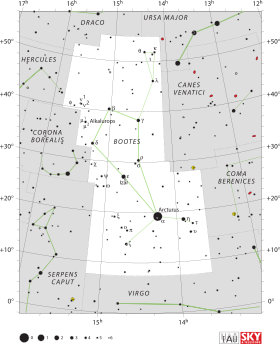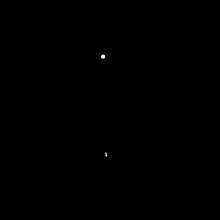Mu Boötis
Mu Boötis, Latinized from μ Boötis, consists of a pair of double stars in the northern constellation of Boötes. The primary pair, components Aa, are designated μ1 Boötis and have an angular separation of 0.08″. The secondary, consisting of components BC, is designated μ2 Boötis and they have a separation of 2.2″. The two double star systems are separated by 107″, with matching parallaxes and proper motions, suggesting they form a system. However, compents BC have a different chemical composition compared to Aa, indicating this may instead be a close encounter between two binary systems.[7]
 | |
| Observation data Epoch J2000 Equinox J2000 | |
|---|---|
| Constellation | Boötes |
| Right ascension | 15h 24m 29.42836s[1] |
| Declination | +37° 22′ 37.7577″[1] |
| Apparent magnitude (V) | 4.31[2] + 6.50[3] |
| Characteristics | |
| Mu1 Boötis | |
| Spectral type | F0 V[4] + ? |
| U−B color index | +0.06[3] |
| B−V color index | +0.31[3] |
| R−I color index | 0.15 |
| Mu2 Boötis | |
| Spectral type | G1 V[5] + ? |
| U−B color index | +0.13[3] |
| B−V color index | +0.59[3] |
| Astrometry | |
| Radial velocity (Rv) | −8.60±0.3[6] km/s |
| Proper motion (μ) | RA: −146.73[1] mas/yr Dec.: +79.85[1] mas/yr |
| Parallax (π) | 26.96 ± 0.65[1] mas |
| Distance | 121 ± 3 ly (37.1 ± 0.9 pc) |
| Orbit | |
| Companion | CCDM 15245+3722 C |
| Period (P) | 260.1 yr |
| Semi-major axis (a) | 1.463″ |
| Eccentricity (e) | 0.59 |
| Inclination (i) | 135.4° |
| Longitude of the node (Ω) | 174.9° |
| Periastron epoch (T) | 1865 |
| Details | |
| Mu1 Boötis | |
| Mass | 1.93±0.03[4] M☉ |
| Radius | 1.9[2] R☉ |
| Luminosity | 20[4] L☉ |
| Surface gravity (log g) | 4.14[2] cgs |
| Temperature | 7,190±140[2] K |
| Rotational velocity (v sin i) | 96[4] km/s |
| Other designations | |
| μ1 Boo: BD+37° 2636, GC 20724, GJ 3903, HD 137391, HIP 75411, HR 5733, SAO 64686 | |
| μ2 Boo: BD37° 2637, GC 20725, GJ 3904, HD 137392, HIP 75415, HR 5734, SAO 64687 | |
| Database references | |
| SIMBAD | μ1 Boo |
| μ2 Boo | |

Mu Boötis had the traditional name Alkalurops /ælkəˈljʊərɒps/, although the International Astronomical Union now regards that name as only applying to μ1 Boötis.[8]
Mu Boötis is approximately 121 light-years from the Sun.
Nomenclature
μ Boötis (Latinised to Mu Boötis) is the star's Bayer designation. It also bears the Flamsteed designation 51 Boötis.
The system's traditional name Alkalurops is from the Greek καλαύροψ kalaurops "a herdsman's crook or staff", with the Arabic prefix attached.[9] It has also been known as Inkalunis (from the Alfonsine tables), Clava (Latin 'the club') and Venabulum (Latin 'a hunting spear').[10] In 2016, the International Astronomical Union organized a Working Group on Star Names (WGSN)[11] to catalogue and standardize proper names for stars. The WGSN approved the name Alkalurops for μ¹ Boötis on 21 August 2016 and it is now so entered in the IAU Catalog of Star Names.[8]
It is known as 七公六, Qī Gōng liù (the Sixth Star of the Seven Excellencies) in Chinese.[12]
Properties
μ1 Boötis is a yellow-white F-type subgiant with an apparent magnitude of +4.31.
Separated from its brighter companion by 108 arcseconds in the sky is the binary star μ2 Boötis, which has a combined spectral type of G1V and a combined brightness of +6.51 magnitudes. The components of μ2 Boötis have apparent magnitudes of +7.2 and +7.8 and are separated by 2.2 arcseconds. They complete one orbit about their common centre of mass every 260 years.
See also
References
- van Leeuwen, F. (2007), "Validation of the new Hipparcos reduction", Astronomy and Astrophysics, 474 (2): 653–664, arXiv:0708.1752, Bibcode:2007A&A...474..653V, doi:10.1051/0004-6361:20078357.
- Malagnini, M. L.; Morossi, C. (November 1990), "Accurate absolute luminosities, effective temperatures, radii, masses and surface gravities for a selected sample of field stars", Astronomy and Astrophysics Supplement Series, 85 (3): 1015–1019, Bibcode:1990A&AS...85.1015M.
- Johnson, H. L.; et al. (1966), "UBVRIJKL photometry of the bright stars", Communications of the Lunar and Planetary Laboratory, 4 (99): 99, Bibcode:1966CoLPL...4...99J.
- Zorec, J.; Royer, F. (January 2012), "Rotational velocities of A-type stars. IV. Evolution of rotational velocities", Astronomy & Astrophysics, 537: A120, arXiv:1201.2052, Bibcode:2012A&A...537A.120Z, doi:10.1051/0004-6361/201117691.
- Abt, H. A. (1981), "Visual multiples. VII. MK classifications", The Astrophysical Journal Supplement Series, 45: 437, Bibcode:1981ApJS...45..437A, doi:10.1086/190719.
- Gontcharov, G. A. (November 2006), "Pulkovo Compilation of Radial Velocities for 35495 Hipparcos stars in a common system", Astronomy Letters, 32 (11): 759–771, arXiv:1606.08053, Bibcode:2006AstL...32..759G, doi:10.1134/S1063773706110065.
- Kiyaeva, O. V.; et al. (November 2014), "The multiple system ADS 9626: A quadruple star or an encounter of two binaries?", Astronomy Reports, 58 (11): 835–848, Bibcode:2014ARep...58..835K, doi:10.1134/S106377291411002X.
- Mamajek, Eric; et al. (June 30, 2017), IAU Catalog of Star Names, IAU Division C Working Group on Star Names, retrieved 28 July 2016.
- Allen, Richard H. (1963), Star Names: Their Lore and Meaning (Reprint ed.), New York: Dover Publications Inc, p. 97, ISBN 0-486-21079-0, retrieved 2016-09-15
- Allen, Richard H. (1963), Star Names: Their Lore and Meaning (Reprint ed.), New York: Dover Publications Inc, p. 105, ISBN 0-486-21079-0, retrieved 2016-09-15.
- IAU Working Group on Star Names (WGSN), International Astronomical Union, retrieved 22 May 2016.
- (in Chinese) AEEA (Activities of Exhibition and Education in Astronomy) 天文教育資訊網 2006 年 6 月 26 日